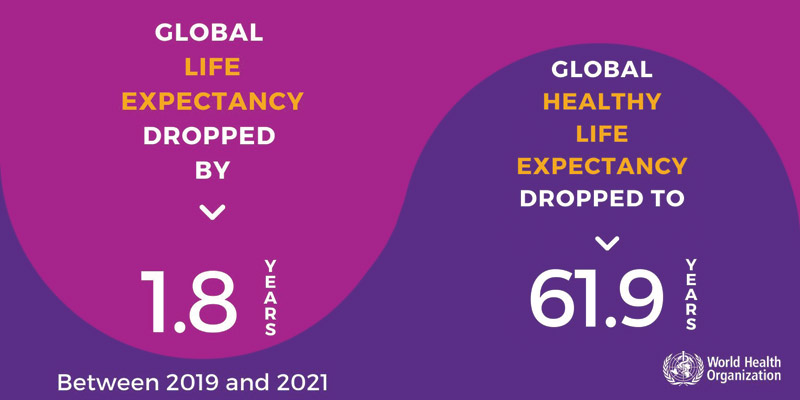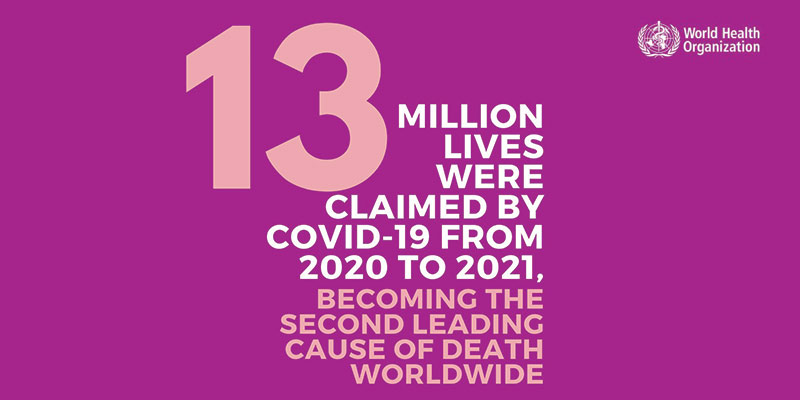- World
- May 25
COVID-19 eliminated a decade of progress in global level of life expectancy
The latest edition of the World Health Statistics released by the World Health Organisation (WHO) reveals that the COVID-19 pandemic reversed the trend of steady gain in life expectancy at birth and healthy life expectancy at birth (HALE).
Between 2019 and 2021, global life expectancy dropped by 1.8 years to 71.4 years (back to the level of 2012). Similarly, global healthy life expectancy dropped by 1.5 years to 61.9 years in 2021 (back to the level of 2012).
What is life expectancy?
• Life expectancy is the most commonly used measure to describe population health and reflects the overall mortality level of a population.
• Life expectancy measures how long, on average, a person is expected to live based on current age and sex-specific death rates.
• In summarising mortality patterns, life expectancy is often expressed as the number of years of life, from birth, a person is expected to live.
• Steady gain in global life expectancy at birth was observed from the turn of the millennium until the onset of the COVID-19 pandemic, up from 66.8 years in 2000 to 73.1 years in 2019.
• However, the COVID-19 pandemic reversed this trend and wiped out the progress that was made in nearly a decade within just two years.
• The 2024 report also highlights how the effects have been felt unequally across the world.
• The WHO regions for the Americas and South-East Asia were hit hardest, with life expectancy dropping by approximately three years and healthy life expectancy by 2.5 years between 2019 and 2021.
• In contrast, the Western Pacific Region was minimally affected during the first two years of the pandemic, with losses of less than 0.1 years in life expectancy and 0.2 years in healthy life expectancy.
Non-communicable diseases remain the top killer
• COVID-19 rapidly emerged as a leading cause of death, ranking as the third highest cause of mortality globally in 2020 and the second in 2021.
• Nearly 13 million lives were lost during this period. The latest estimates reveal that except in the African and Western Pacific regions, COVID-19 was among the top five causes of deaths, notably becoming the leading cause of death in the Americas for both years.
• The WHO report also highlights that non-communicable diseases (NCDs) such as ischemic heart disease and stroke, cancers, chronic obstructive pulmonary disease, Alzheimer’s disease and other dementias, and diabetes were the biggest killers before the pandemic, responsible for 74 per cent of all deaths in 2019. Even during the pandemic, NCDs continued to account for 78 per cent of non-COVID deaths.
Increasing obesity and malnutrition
• The world faces a massive and complex problem of a double burden of malnutrition, where undernutrition coexists with overweight and obesity.
• In 2022, over one billion people aged five years and older were living with obesity, while more than half a billion were underweight.
• Malnutrition in children was also striking, with 148 million children under five years old affected by stunting (too short for age), 45 million suffering from wasting (too thin for height), and 37 million overweight.
• The report further highlights the significant health challenges faced by persons with disabilities, refugees and migrants.
• In 2021, about 1.3 billion people, or 16 per cent of the global population, had disability. This group is disproportionately affected by health inequities resulting from avoidable, unjust and unfair conditions.
• This highlights the urgent need for health systems to adapt and address the persisting inequities and changing demographic needs of global populations.
Other key points of the report:
• The world is off-track to achieve the universal health coverage (UHC), health emergencies preparedness and healthier populations “Triple Billion” targets by 2025.
The Triple Billion targets are an ambitious initiative to improve the health of billions.
The goals of the Triple Billions are:
i) 1 billion more people benefitting from universal health coverage.
ii) 1 billion more people better protected from health emergencies.
iii) 1 billion more people enjoying better health and well-being.
• From the 2018 baselines, 585 million more people are expected to have access to essential health services without incurring catastrophic health spending by 2025, well short of the one billion UHC target.
• For health emergency preparedness, 777 million more people are expected to be protected by 2025, again short of the target.
• Healthier populations is the sole area positioned to meet its one billion target, with 1.5 billion additional people anticipated to be living healthier lives by 2025.
• But acceleration across all three areas is needed to achieve broader health-related SDGs by 2030.
• Refugees and migrants are not inherently less healthy than host populations, yet various sub-optimal health determinants — further exacerbated by linguistic, cultural, legal and other barriers — mean that they often experience significant health disparities.
• Access to healthcare is often limited for refugees and migrants, with only half of the 84 countries surveyed between 2018 and 2021 providing them access to government-funded health services on par with nationals.
• Lack of quality data further obstructs understanding of their needs and tracking progress on health goals.
Manorama Yearbook app is now available on Google Play Store and iOS App Store


